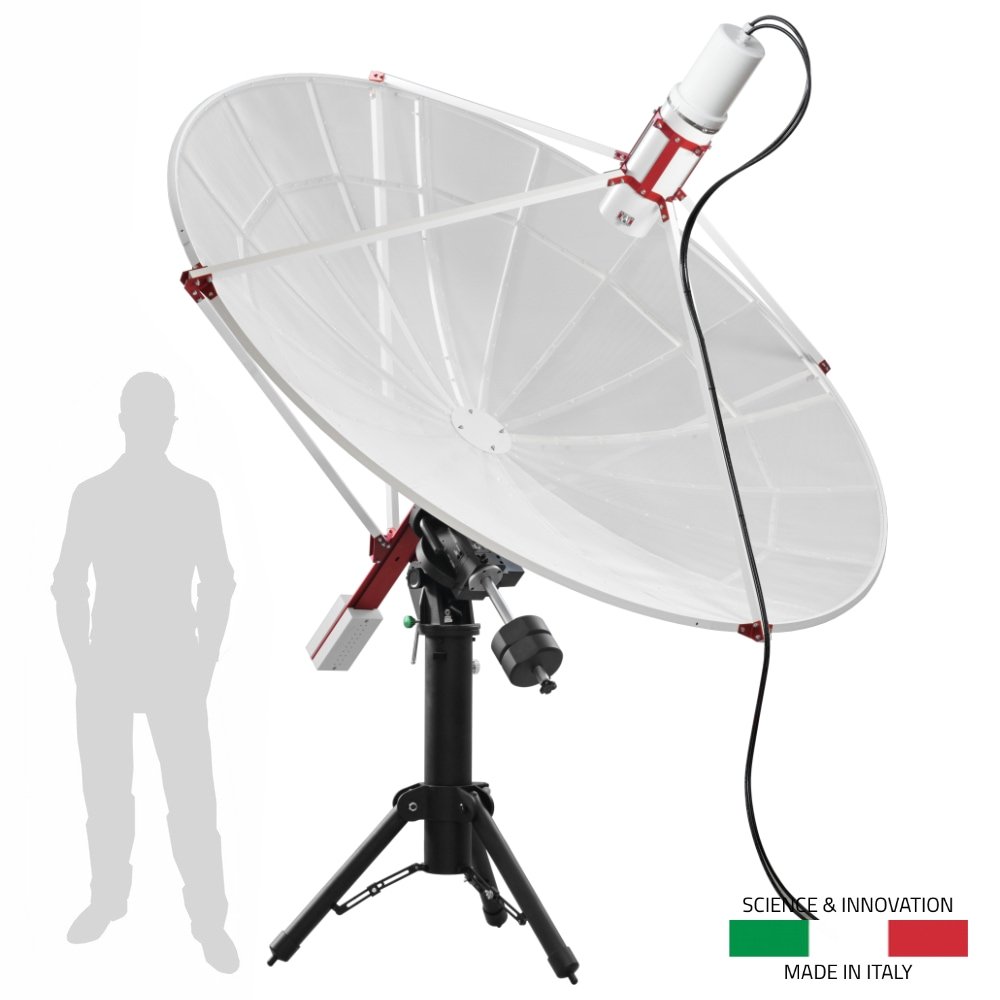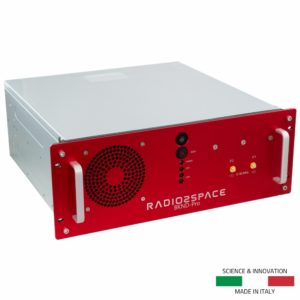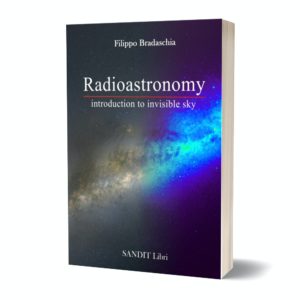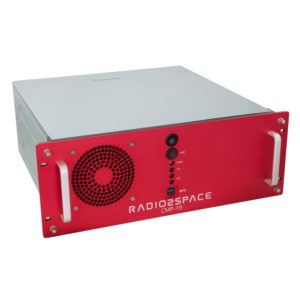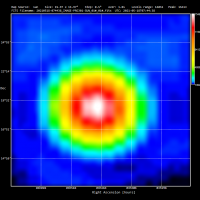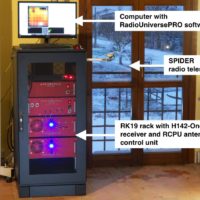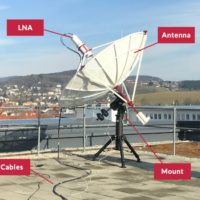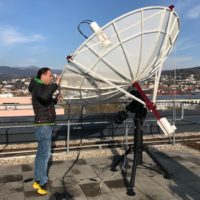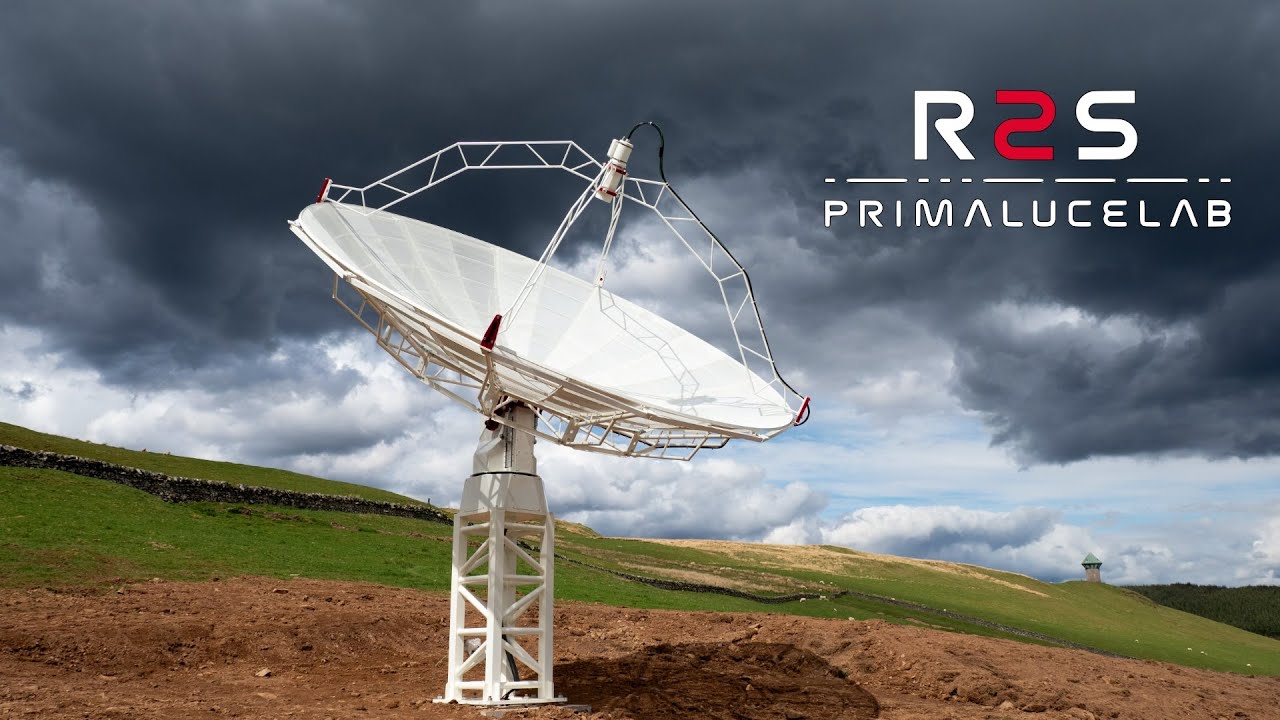SPIDER 230C 2.3 meter diameter compact radio telescope (kit without mount): main features
- SPIDER 230C 2.3 meter radio telescope: it allows the use of an EQ mount to create a compact radio telescope!
- WEB230-5 2.3 meter diameter prime focus antenna with special designed front and rear supports: it comes with 1420 MHz optimised feed and 2 LNAs for LHCP and RHCP circular polarisation.
- Equatorial mounts support device allows to use the parabolic antenna on an equatorial mount.
- Mount with tripod is not included in the “SPIDER 230C kit without mount” and must be added separately in order to use the radio telescope.
- H142-One 1420 MHz radio astronomy receiver, 50 MHz instantaneous bandwidth radiometer and 1024 channels spectrometer to be installed in the control room on a standard 19″ rack or on a table.
- RadioUniversePRO control and acquisition software for Windows 10/11, designed to control all devices of SPIDER radio telescope and to collect radio astronomy data.
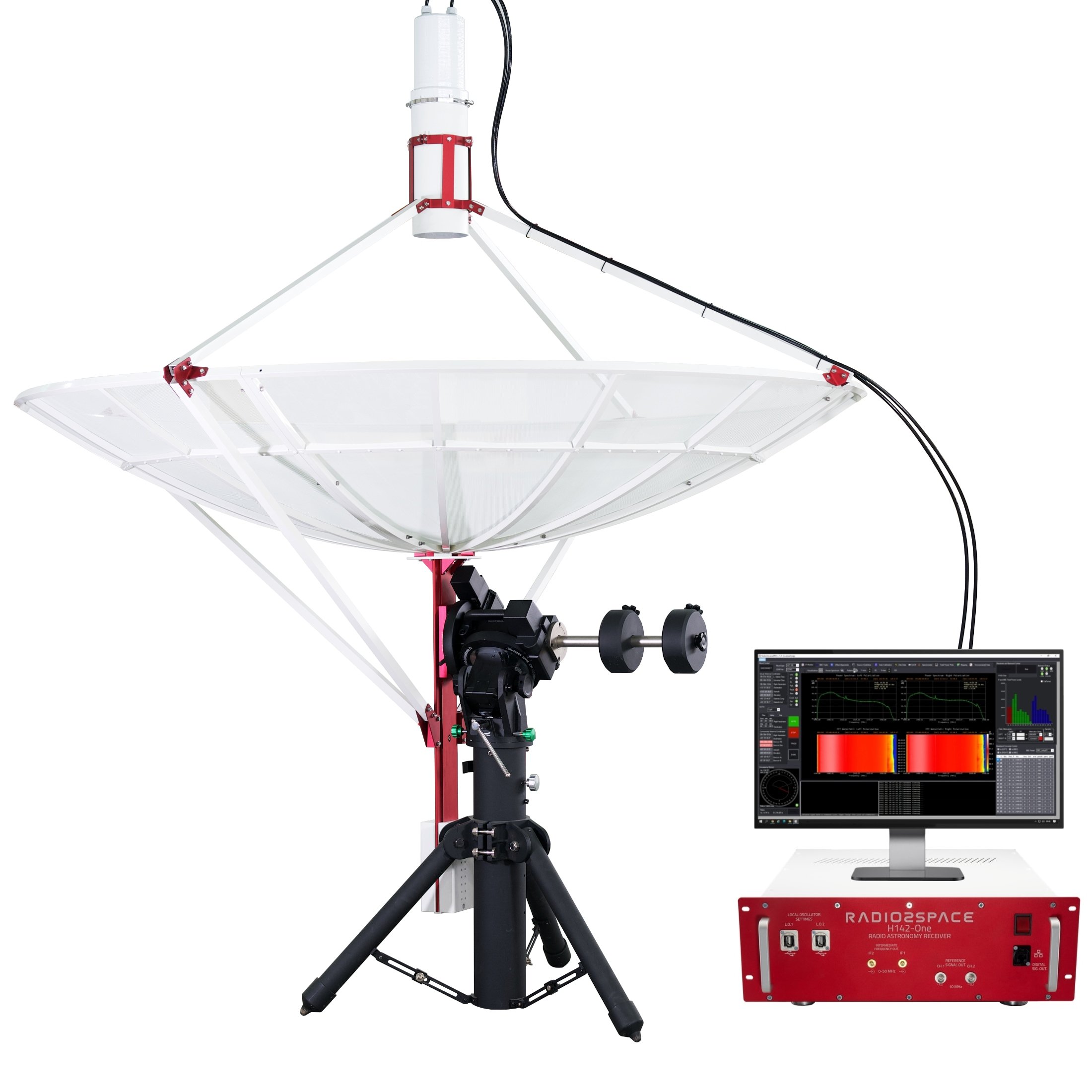
The SPIDER 230C compact radio telescope uses the WEB230-5 antenna, a mesh 2.3-meter diameter parabolic antenna designed to offer a larger diameter with lower overall weight. The 230C weighs much less than a normal 1.5 meter diameter full-surface model, offering better resolution capacity due to its greater diameter while maintaining a lower sensitivity to wind due to the perforated surface of the antenna. The reflecting surface of this antenna (the primary reflector) is composed of an aluminum mesh with 3×4 mm holes for optimum reflectivity of radio waves with frequencies up to 5 GHz.
Designed to be used with equatorial mounts
SPIDER 230C compact radio telescope is designed to be used with computerized equatorial mounts like those used by amateur astronomers with normal optical telescopes. These mounts offer, a high load capacity and pointing/tracking precision at a low price. You can use the SPIDER 230C with your equatorial mount (in order to work, the “SPIDER 230C kit without mount” requires an equatorial GOTO mount with at least 50 kg payload capacity, Losmandy-type style dovetail clamp). The mount is controlled by our RadioUniversePRO software through the ASCOM platform so if you want to use your mount, please verify that it comes with an available ASCOM driver updated for ASCOM Platform 6.
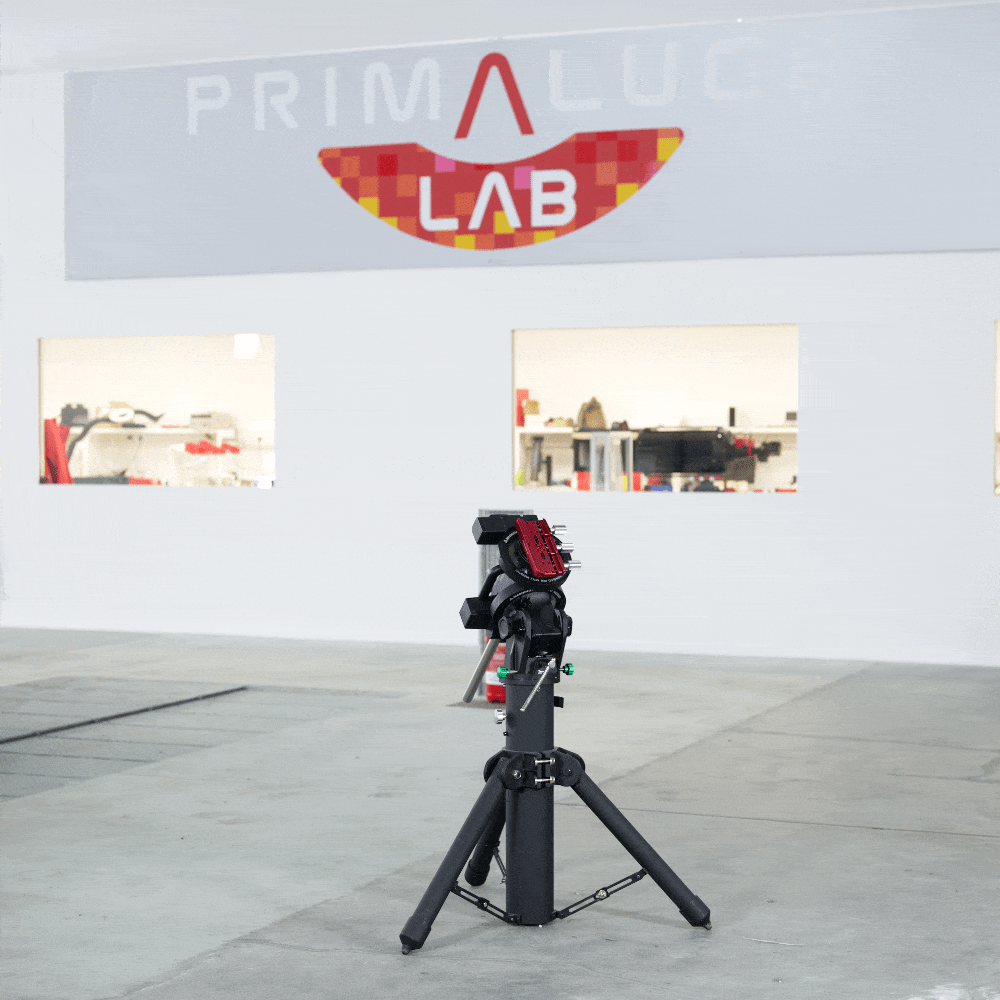
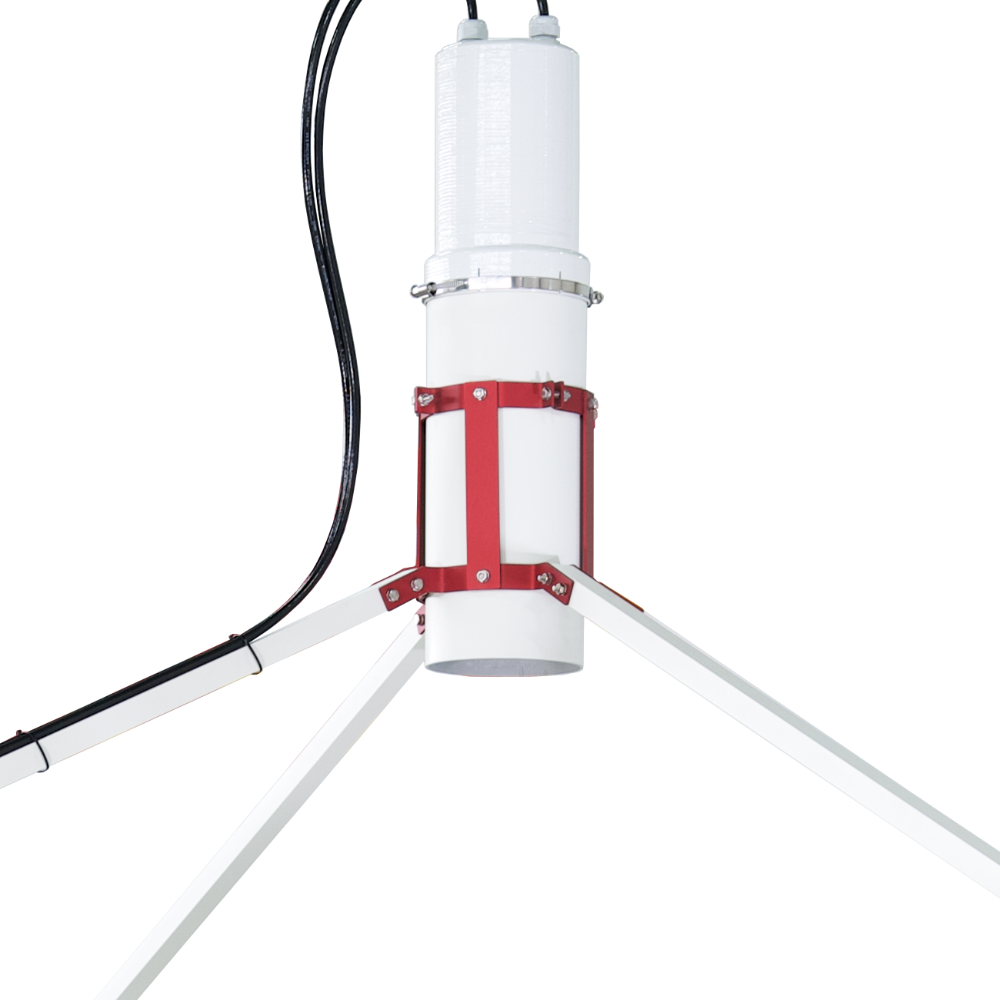
H-FEED: the 1420 MHz optimized feedhorn
Developed specifically for SPIDER radio telescopes, the H-FEED feedhorn is designed for optimal illumination of the primary reflector, allowing for high gain while reducing side lobes and the spillover effect, thus obtaining the best possible performance from the 2.3 meter parabolic antenna. The feedhorn is designed to allow the reception of dual polarization with support for two professional Low Noise Amplifiers (LNA) for the 1420 MHz frequency. The feedhorn is positioned at the perfect point of focus of the antenna through a rigid structure with four supports to minimize obstruction, with a focusing device to precisely focus and maximize the performance of the entire radio telescope.
Equatorial mounts support device
Our equatorial mounts support device (patented) allows you to install the WEB230-5 antenna on any equatorial mount (with Losmandy dovetail and load capacity of at least 50 kg, ie. EQ8 type). Thanks to a two-counterweight-sliding system to protect against accidental drops, you can get a perfect balance even in the declination axis for maximum tracking and automatic goto performance of the mount. Without counterweights the radio telescope would be completely biased towards the front (because of the weight of the primary reflector and LNA + feedhorn group with support rods) and therefore could not properly point and track objects in the sky. A special system of rear tie rods increases the rigidity of the structure while minimizing the deformation of such a large diameter parabolic antenna.
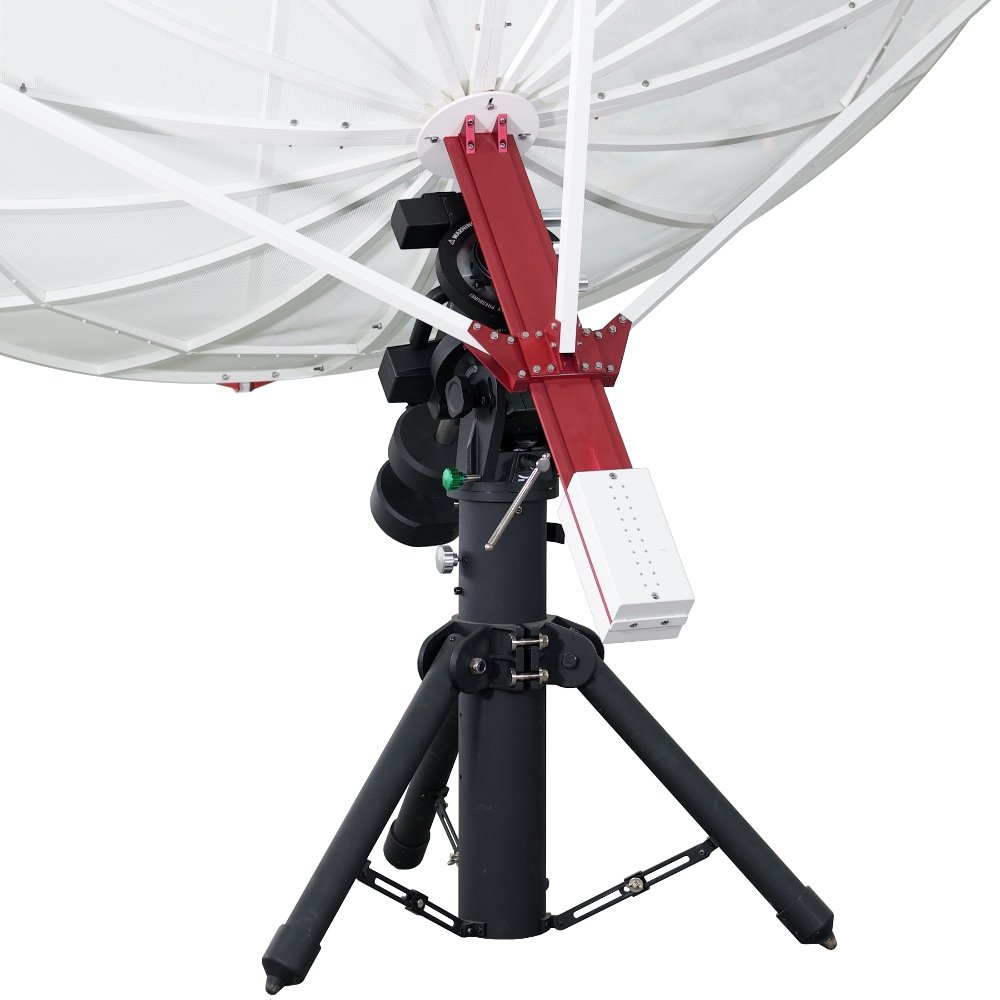
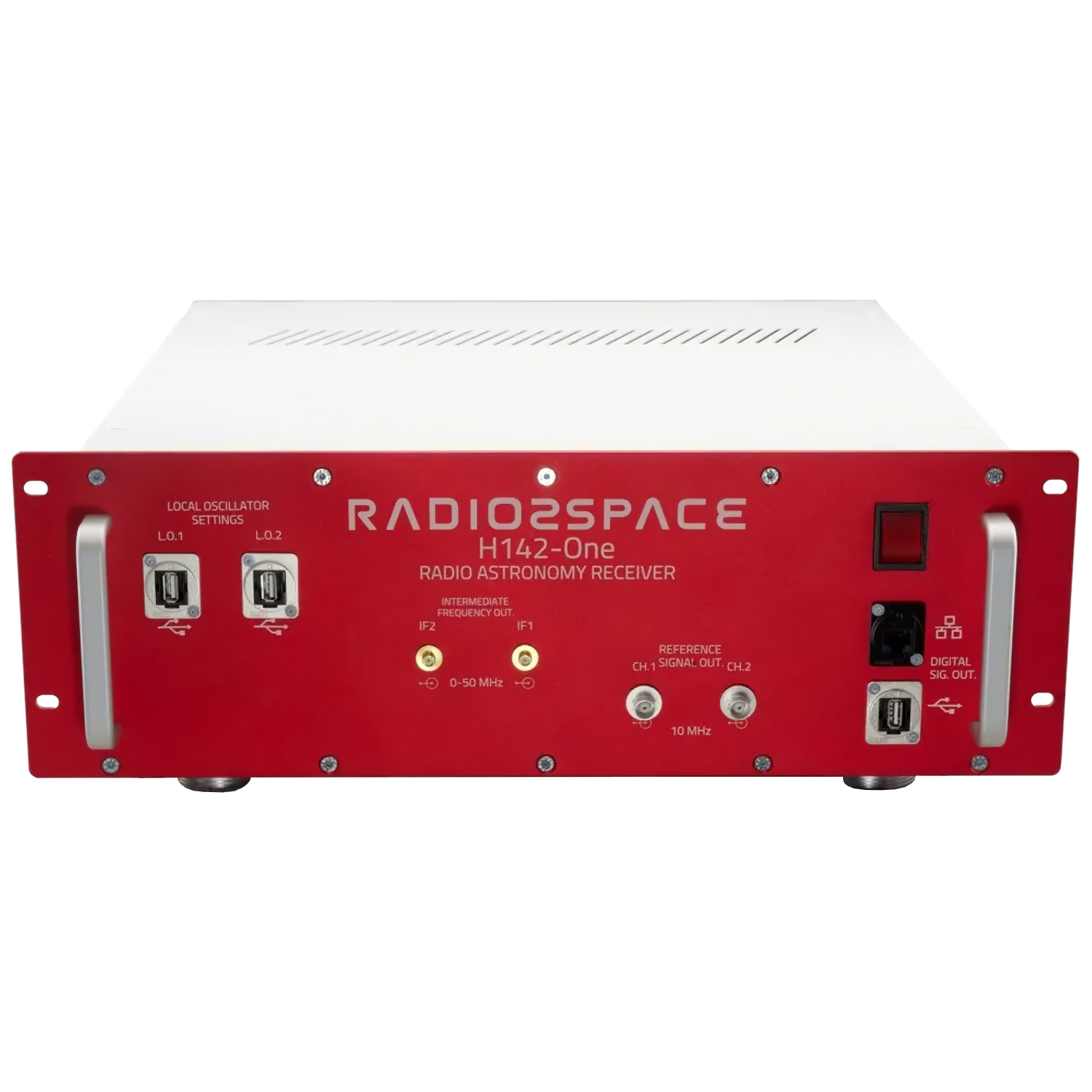
H142-One: the 1420 MHz receiver for radioastronomy, radiometer and spectrometer
H142-One receiver has been specially developed together with Bologna INAF Institute of Radio Astronomy specifically for SPIDER radio telescopes. H142-One provides professional technologies used by radio astronomers for radio astronomy research in a scientifically certified and easy to use receiver, perfect even with compact size antennas: it’s a 1420 MHz superheterodyne type radiometer/spectrometer, double conversion (type UP/DOWN) with 50 MHz received instantaneous bandwidth (RF=1.395MHz-1.445MHz) and 14-bit analog to digital converter. The H142-One receiver has spectrometer with 1024 channels (61 KHz spectral resolution) that are displayed and processed in real time by the control software supplied with the radio telescope. The H142-One receiver can be installed on a 19″ rack but it can also be placed on a table close to the control computer. Thanks to two dedicated IF outputs, the H142-One radio astronomy receiver allows to even improve performances by adding the optional BKND-Pro professional backend making this the perfect instrument for educational and research institutions that want to create a radio astronomy program.
RadioUniversePRO: the control, data capture and processing software for radio astronomy
SPIDER 230C comes with RadioUniversePRO that is the most advanced software ever developed for real radio astronomy with compact radio telescopes: it gives you all the power to control the different components of your radio telescope with an immediate and easy-to-use interface. You do not have to worry about using different softwares, RadioUniversePRO is your intuitive control and data acquisition interface with the radio telescope. It allows you to control the antenna position and acquisition parameters of the receiver. This way you cannot only record data coming from the sky (deleting eventual artificial signal interferences) but also transits or radio-images of radio sources in the sky you want to study. RadioUniversePRO lets you save recorded data in graphical format as visualized on the user interface but you can also save raw data in FITS format compatible with NASA FITS Viewer, this way you can quickly open and view their data and export them to process with other softwares. System requirements are Windows 10/11 (suggested: 64 bit version), screen resolution at least 1920 x 1080, RAM memory 4 GB (suggested: 8 GB), processor i3 (suggested: i5 or i7). RadioUniversePRO is not sold separately and is supplied only with SPIDER radio telescopes. If you want to know more about RadioUniversePRO radio astronomy software for SPIDER radio telescope, click here to read the article.
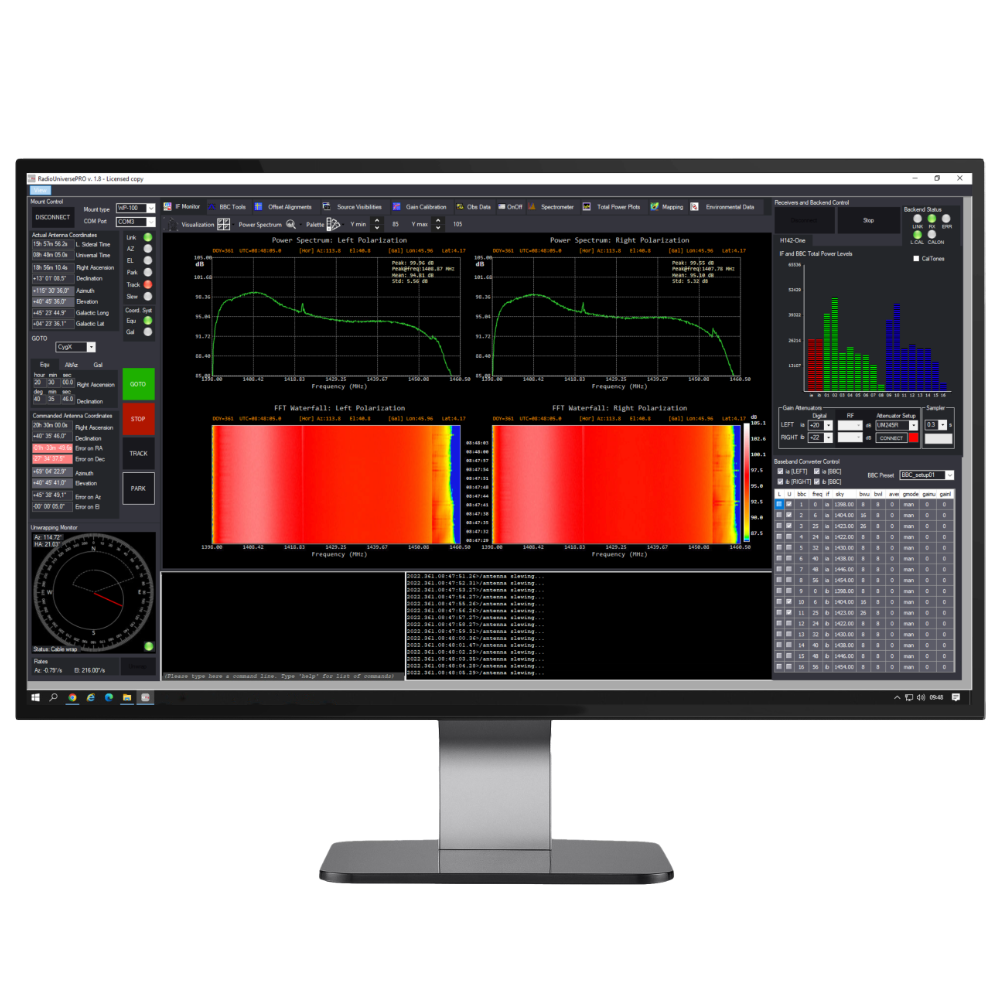
SPIDER 230C 2.3 meter diameter compact radio telescope (kit without mount): specifications
- Antenna diameter (m): 2.3
- Antenna type: Prime focus
- Feed: optimised for 1420 MHz, LHCP and RHCP
- Working frequency: 1395 – 1445 MHz
- Bandwidth: 50 MHz
- LNA: 2 high gain and stability 1420 MHz LNA units
- Radiometer: 50 MHz instantaneous bandwidth
- A/D converter: 14 bits
- Spectrometer: 1024 channels
- Spectral resolution: 61 KHz
- Control software: RadioUniversePRO
- Weatherproof: No
- Continuous wind speed for operational tracking: 25 km/h
- Supply voltage: 1x12V DC + 1×220V AC
SPIDER 230C 2.3 meter diameter compact radio telescope (kit without mount): site preparation
SPIDER 230C radio telescope is not provided with an equatorial mount (we suggest the use of a EQ8 SynScan mount, you can read how to use it in the SPIDER 230C user manual) that must be added in order to make it work. Please note that, since the mount is not weatherproof, you can’t leave the SPIDER 230C permanently installed in the field without a protection (if you want this feature, please consider the 300A and 500A radio telescopes). The image below shows cables and connections that are needed to connect antenna external unit to the control room. Power and grounding systems are needed and they have to be provided by the customer.
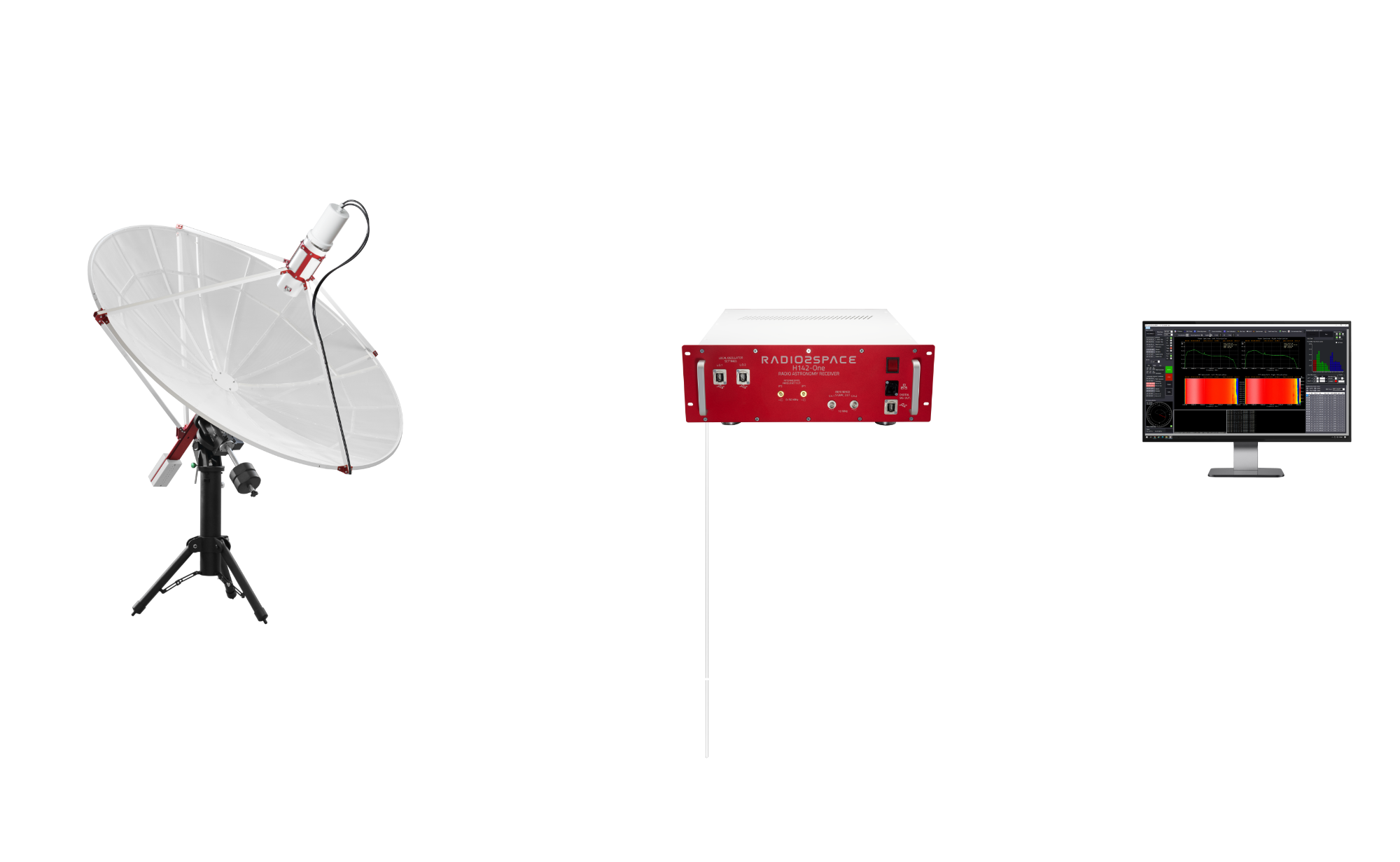
SPIDER 230C 2.3 meter diameter compact radio telescope (kit without mount): optional accessories
- BKND-Pro professional backend: by adding it to H142-One receiver of SPIDER radio telescopes, BKND-Pro backend allows you to sample the signal with higher spectral resolution than the integrated H142-One spectrometer, this way bringing the most advanced professional technology to the world of education for radio astronomy and SETI applications with SPIDER radio telescopes.
- CMP-19 computer for SPIDER radio telescopes: this is a Windows 10 Pro computer that can be installed on a standard 19″ rack and it’s the best solution to install RadioUniversePRO software and remotely control SPIDER radio telescopes. CMP-19 has the same form factor of all the other Radio2Space instruments that can be installed on a rack.
- RK19 rack for SPIDER radio telescopes: it’s the rack designed to allow you install all the receivers and accessories that fit in a 19″ rack. RK19 has 24 units, it comes with a Power Distribution Unit (PDU) to let you connect (with remote on/off) up to 8 devices and 4 fans with temperature sensor to keep control on your devices temperature.
- “Radioastronomy: introduction to invisible sky” book: Are you interested in radio astronomy? Do you want to know how do radio telescopes work? This book will allow you to discover the amazing world of the Universe that our eyes cannot see but that we can study with radio techniques. Author Filippo Bradaschia (founder of PrimaLuceLab) explains the different themes of this science in a simple and understandable format thanks to a series of pictures and illustrations and where possible without using complicated formulas.

SPIDER MarkII radio telescopes for radio astronomy: much more than an antenna
SPIDER MarkII radio telescope is the result of 10 years in research by PrimaLuceLab engineering team that designs, develops, assembles and tests in-house all our radio telescopes. This way SPIDER MarkII radio telescopes provide unmatched performance by standard off-the-shelf antennas that are not designed for radio astronomy: better tracking and pointing precision, higher sensitivity, dedicated radio astronomy software, better engineering quality and great italian design!
Since we create SPIDER MarkII radio telescopes in our factory in Italy, you can take advantage of the direct relation with the us that are the real radio telescope manufacturer. Our pre-sale service can help you in everything you may need before your radio telescope order. Our post-sale support can provide you with updates for hardware and software products that we specifically develop for our radio telescopes. Our internal team of trained technicians is also able to install SPIDER MarkII at your location, all around the World!

